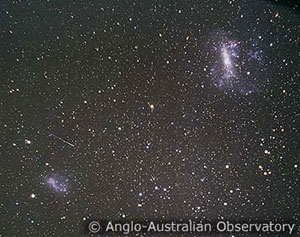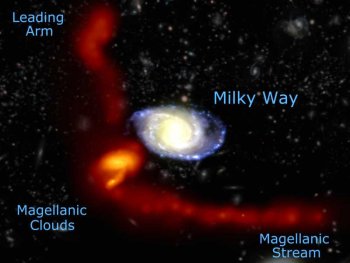Magellanic Clouds

Figure 1. The Magellanic Clouds.

Figure 2. Image from a simulation of the gas in, and streaming from, the Magellanic Clouds. Simulation by Daisuke Kawata, Chris Fluke, Sarah Maddison, and Brad Gibson, Swinburne University of Technology, Australia.
The Magellanic Clouds are two irregular, satellite galaxies of our own Galaxy which are visible from the Southern Hemisphere as misty patches in the night sky. The Large Magellanic Cloud and Small Magellanic Cloud are named after the Portuguese explorer Ferdinand Magellan (1480–1521), who described them during his voyage round the world. Riding at close quarters to each other, barely 100,000 light-years apart, it is possible that the Magellanic Clouds are destined at some time to merge into a single galaxy. Together with at least two other satellite galaxies of the Milky Way, the Draco Dwarf and the Ursa Minor Dwarf, they move within an enormous river of hydrogen gas known as the Magellanic Stream.
Magellanic Stream
The Magellanic Stream is a filament of neutral hydrogen, spanning roughly 300,000 light-years, that may have been torn out of the Magellanic Clouds by the Milky Way Galaxy some 200 million years ago. It forms an arc in the southern sky about 150° long, stretching from the region between the Magellanic Clouds and passing close to the south galactic pole.


